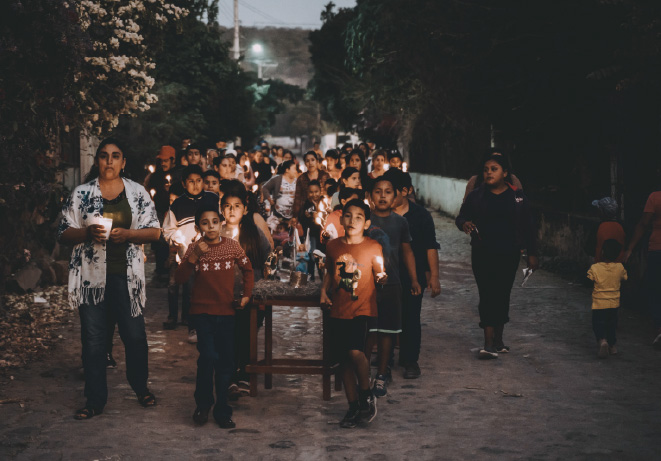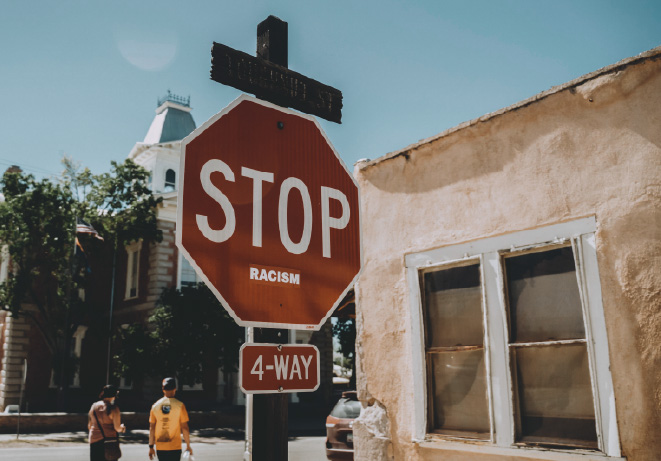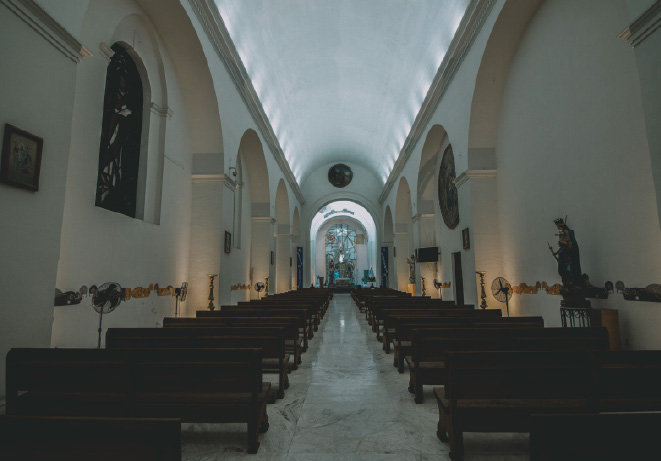Mexicans as well as foreigners think that racism or racial injustice does not exist in Mexico, especially if compared with other countries where there is a strong dual racism.[1] This perception probably came from the European conquest of Mexico and Latin America, during which the mixing of races was promoted and resulted in a mixed-race (mestizaje) majority of the population.[2]
However, some scholars who have studied this mestizaje phenomenon since the historical time of colonization to the present day affirm that the mixing between Europeans and indigenous people did not really happen in big numbers, nor were they considered as equals. There was always the idea that the indigenous people were inferior to the Europeans. Even in cases where the mixing of the races was encouraged, the conquistadors’ goal seemed to be the extinction of the indigenous race through its ‘whiteness’.[3]
Racism in Mexico and in many other parts of Latin America has been for many years a very difficult issue to be recognized or even mentioned.
Racism in Mexico and in many other parts of Latin America has been for many years a very difficult issue to be recognized or even mentioned. Historically we Latin Americans had preferred not to acknowledge its existence and had therefore been blind to it, but it is noticeable in many areas of life—in our language, our daily phrases, our jokes, our personal relationships, and inside our families and schools where we are objects as well as subjects of racial discrimination.
It also exists in the public square: for example, in our attitudes toward certain types of migrants. We practice racism consciously or unconsciously. There could be subtle discrimination when the tone of one’s skin and one’s physical features determine access to opportunities and the levels of poverty or wealth. This kind of subtle discrimination is related to another called ‘classism’.[4] The author Gómez Bruera affirms that racism-classism in Mexico is a permanent pursuit of ‘whiteness’, not necessarily through marriages with people with whiter skin, but also through attitudes of ‘whitexicans’.[5]
Racial Injustice in the Context of Mexico and Latin America
There are many groups and levels of the population in Mexico in need of racial justice. Here are two of the more salient examples among the discriminated and marginalized groups in the country.
Since the time of colonization until now, the native people have been seen as primitive in comparison to people from other countries—uncivilized, superstitious, isolated from the outer world, and even comfortable living in poverty. Therefore, one example of racial injustice in Mexico is the result of a structural phenomenon in which a sector of the population has been oppressing another over a long period of time through a relationship of power.[6]
Another example of racial injustice is seen in attitudes towards migrants.[7] Very few people know that during the end of the nineteenth century and the beginning of the twentieth century, the Mexican government rejected the immigration of some racial groups (such as the Chinese, Jews, Arabs, Gypsies, and others), because they were considered as being of little benefit to the country. By contrast, immigration from European countries was promoted. This promotion was not successful, however, and the few who migrated from Europe always avoided engaging with the local population, let alone with the indigenous people.
This is an interesting historical antecedent of the current massive migrant movement from Central America to the United States which encounters political hostility. Until recently, these migrants received permits to cross the country, though they still experienced discrimination and marginalization.[8] There are studies that show that migrants from Central America passing through Mexico towards the US and those remaining in Mexico experienced racial discrimination.
If the migrants are Europeans or have lighter skin, they are received with open arms and respect. But if they are people of colour, they are treated either with indifference or with hostility, contempt, or even mockery.
However, this discrimination is not the same in all cases, but selective. If the migrants are Europeans or have lighter skin, they are received with open arms and respect. But if they are people of colour, they are treated either with indifference or with hostility, contempt, or even mockery. Social rejection of migrants has been rising in Mexico in the last few years. A 2019 survey shows that 63 percent of Mexicans disagree with allowing migrants to remain and work in the country, and 52 percent believe that the government should pressure them to go back to their own countries, instead of protecting them and offering humanitarian help to them.
The Impact of the Church
For nearly two centuries, the testimony of us evangelicals in Mexico in general, and Baptists in particular, has varied, with our impact recognized by many but valued in different ways. We are recognized as being educated, building good organization structures in our churches, being interested in missions, and believing in religious freedom. However, we are also seen as an exclusive group with a lack of social commitment and an ambiguous political position, given our principle of separation between church and state.[9]
On the other hand, there is one encouraging example of the collaborative responses to the growing migrant groups in recent times, especially those located in the northern border with the US, between Ciudad Juárez, Mexico, and El Paso, Texas. There, the churches, the civil society, and the bi-national community have been key in providing relief to the immigration crisis.
‘Since 2018 the organizations have given response to all those migration waves,’ says Rodolfo Rubio Salas, research professor of El Colegio de Chihuahua (El Colech). He adds, ‘They continue giving the main help to each migrant flow, because many times the government responses arrived too late.’[10]
Meanwhile, churches from different denominations provide daily meals to thousands of individuals and host hundreds of families, some by paying for hotel rooms for migrants who feel cornered by different authorities. Emilio López Reyes, professor of Universidad Autónoma de Chihuahua (UACH), also affirms that civil society and faith communities have managed the migration situation well in this region, preventing a social catastrophe. Thus, Ciudad Juárez has been outstanding in its attention to migrants through both secular and religious organizations, even though in many cases their facilities, such as hostels and dining rooms, are already overburdened.[11]
Challenges and Recommendations for Mission in the 21st Century
We must demonstrate the whole gospel with all its implications for the whole person in this context, avoiding the temptation of proclaiming a gospel of fast consumption that is without conversion, without solid discipleship, and without social commitment.
The economic and political situation in Mexico and Latin America is a complex challenge to Christians, yet one which demands their response. The worldwide socio-economic crisis concerns this region marked by the presence of extreme poverty and scandalous inequality. Latin America is considered a ‘Catholic Christian’ continent with more church buildings per square meter and per inhabitant than any other continent, but at the same time its people are saddled with much poverty and misery.
It is imperative for Christians to practice our theological identity in our daily lives holistically. People are looking for answers that are not only spiritual but also material and fundamental: for refuge, for restoration, for rehabilitation to continue living, and even for how to make sense of life.[12] We are to take up this challenge and opportunity of sharing the gospel in an integrated way in this impoverished region of the world. In other words, we must demonstrate the whole gospel with all its implications for the whole person in this context, avoiding the temptation of proclaiming a gospel of fast consumption that is without conversion, without solid discipleship, and without social commitment.
We can learn from our predecessors who tried to proclaim the whole gospel message to a spiritually needy people in the face of material and cultural barriers.[13] We need to recognize that the first evangelicals on this soil had such a quality of Christian life that their transformed lives led them to be willing even to suffer. In the context of racial injustice, inequality, and discrimination, this is a challenge confronting us with the opportunity to renew our commitment to our heritage and to the mission ahead in this twenty-first century.
Concluding Reflection
The biblical principle of the priesthood of all believers is against arbitrary, authoritarian, hierarchical, and discriminatory styles of leadership influenced by our culture. Evangelical churches in Latin America, like in other parts of the world where injustice and impunity are rampant, should practice a perspective of justice in the mission of our church which compels us to step outside the comfort of our buildings and partner with civil groups for the sake of promoting and respecting human rights.
In my own experience, despite the great social needs surrounding us, many churches do not see justice as a gospel value. As a result, even though the gospel might be proclaimed by preaching and teaching, sometimes our deeds show that we condone practices of discrimination and marginalization, and this produces ethical incongruency.[14]
If we want to be churches that preach an integral gospel promoting and respecting civil rights, we must do this both inside and outside our churches. Doing so will demonstrate our evangelical convictions. This participation deserves a well-planned strategy. Programs of assistance to the poor are good and necessary, but we must first expose the unjust social systems that facilitate injustices in the society as well as in our churches.
Endnotes
- Dual racism is racism between two races that are very well or explicitly differentiated.
- This article is a summary of the author’s presentation at the Forum of Annual Meeting BWA, Birmingham, Alabama, July 2022.
- Federico Navarrete, México racista: Una denuncia (México: Penguin Random House, 2016), 106; Basave B. Agustín, México mestizo: Análisis del nacionalismo mexicano en torno a la mestizofilia (México: FCE, 1992), 26–27; Olivia Gall, ‘Identidad, exlusión y racismo: Reflexiones teóricas y sobre México,’ Revista Mexicana de Sociología 66, no. 2 (2004): 240. Unless otherwise noted, all translations are my own.
- Hernán Gómez Bruera, El color del privilegio: El racismo cotidiano en México (México: Editorial Planeta, 2021).
- Ibid.
- Gómez Bruera, 26–31.
- Editor’s note: See ‘Racism and the Great Commission’ by CJ Davison & Richard Colem in the March 2021 issue of Lausanne Global Analysis, https://lausanne.org/content/lga/2021-03/racism-and-the-great-commission.
- Gómez Bruera, 191–206.
- Carlos Mondragón González, ‘Minorías religiosas y contexto social en la América Latina, siglo XX,’ in Minorías religiosas: El Protestantismo en América Latina, eds. Carlos Mondragón González and Carlos Oliver Toledo (México: Centro de Investigación sobre América Latina y el Caribe, UNAM, 2013), 47–51.
- Hérika Martínez Prado, ‘Han evitado Iglesias, Catástrofe,’ El Diario de Juárez (January 31, 2023): 1.
- Ibid.
- Dinorah B. Méndez, ‘Crisis en el Liderazgo Latinoamericano: Entre la Intolerancia y la Inconsistencia,’ in Buenas Nuevas desde América Latina, ed. Nelson Morales (Lima: Ediciones Puma, 2018), 141.
- Samuel Escobar, The New Global Mission: The Gospel from Everywhere to Everyone (Downers Grove, IL: IVP Academic, 2003), 39.
- Méndez, ‘Crisis en el Liderazgo Latinoamericano.’





